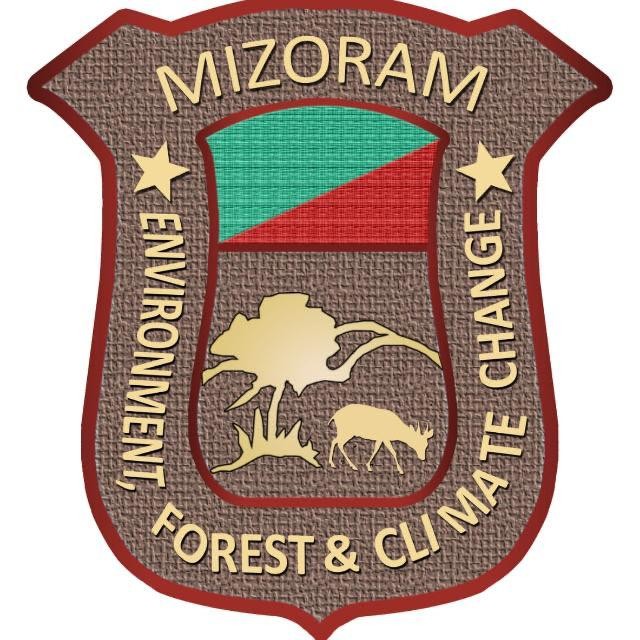
Forest types of Mizoram
Based on past studies as well as from the field observations, Singh et al. (2002) described the forest types of the State based mainly on altitude, rainfall and dominant species composition. The classification is as follows:-
1. Tropical Wet Evergreen Forest
2. Montane sub-tropical Forest
3. Temperate Forests
4. Bamboo Forests
5. Quercus Forests
6. Jhumland.
1. Tropical wet evergreen and semi-evergreen forests:
These forests usually occur below an altitude of 900m and form one of the major forest types of the State with rich species diversity. Patches of these forests can be seen usually on the steep slopes, rocky and steady river banks and areas not suitable for shifting cultivation. The exact distinction between the evergreen and semi-evergreen forests is difficult as they occur in the areas of similar characteristics where rainfall averages between 2,000-2,500mm annually and temperature varies between 20oC to 22oC. Tropical wet evergreen forests are met usually in southern and western part of Mizoram, while semi-evergreen forests occur in northern, north-western and central part of the State.
The tropical wet evergreen forests exhibit clear zonation or canopies consisting of an admixture of numerous species with dense and impenetrable herbaceous undergrowth. Most of the species of the top canopy are evergreen trees with tall boles. Cauliflory is rather common. The middle and lower canopies are dense, evergreen and diverse. Epiphytes and parasites are few. Tree ferns, aroides, palms, ferns, orchids, bryophytes and lichens are fairly common. Lianas are frequent and conspicious, sedges and grasses are common in humid places or along the banks of rivers and rivulets. Species of Musa are also common along the streams on hilly slopes.
In exposed and drier areas, having a thin of soil, deciduous elements along with some evergreen trees are found. Sometimes these are grouped as distinct type, referred as tropical moist deciduous forests. The distinction between the tropical evergreen forests and tropical moist deciduous forests is difficult as they are found in the small hill ranges.
The third storey of canopy consists of smaller trees and shrubs with maximum floristic diversity.
2. Montane sub-tropical forests:
These forests are usually found between 900 and 1,500 m altitude in the eastern fringes bordering Chin Hills of Myanmar, and places which are cooler and have less precipitation. Sub-tropical vegetation shows mixed pine forests. The common species of these forests are Castanopsis purpurella Duabanga grandiflora, Myristica spp., Phoebe goalparensis, Pinus kesiya, Podocarpus neriifolia, Prunus cerasoides, Quercus acutissima, Q.semiserrata, Schima wallichii, etc.
3. Temperate forests:
These forests usually occur above the elevation of 1,600m in areas like Lengteng, Naunuarzo, Pharpak, Thaltlang, Phawngpui reserve forests and display impenetrable virgin primary forests. These forests are not typical temperate forests as found elsewhere in eastern Himalaya. The predominant arboreal elements in the forests are Pinus kesiya, Actinodaphne microptera, Betula alnoides, Exbucklandia populnea, Elaeocarpus serratus, Dillenia pentagya, Michelia doltsopa, M. Champaca, Garcinia anomala, Schisandra neglecta, Photinia intergrifolia, Litsea salicifolia, Myrica esculenta, Lithocarpus dealbata, Rhododendron arboreum, etc.
4. Bamboo forests:
Bamboos usually grow as an under-storey to the tree species in tropical evergreen and sub-tropical mixed-deciduous forests, whereas Melocanna baccifera forms dense or pure forests in certain areas in the State. Large tracts of bamboos are seen throughout Mizoram but their distribution is somewhat restricted to about 1,600m and below. They occur mostly between 40m and 1,520m in tropical and sub-tropical areas. Few species occur in temperature areas in Blue Mountain and Mount Chalfilh. It appears that bamboos have resulted from jhumming system of cultivation (Deb and Dutta, 1987). For practicing jhum cultivation the forests are burnt and tree species are destroyed but the bamboo rhizomes throw out new culms as soon as favourable temperature and seasonal monsoon arrive. Therefore, in abandoned jhumland they are the first colonizer and grow rapidly. Some important associates found growing along with bamboos are Emblica officinalis, Litsea monopetala, Pterospermum acerifolium, Terminalia myriocarpa, Caryota mitis, Artocartus chama, Duabanga grandiflora, Albizia procera, Gmelina arborea, Syzygium species (Singh et sl., 2002).
5. Quercus forests:
These forests are mostly found intermingled in sub-tropical and temperate areas. Pure patches or predominate Quercus griffithiana is present near Champhai-Baite hill ranges and its distribution is restricted to other small areas in the eastern part of Mizoram. Lithocarpus dealbata is other main species (Singh et al., 2002).
6. Jhumland:
Jhumlands are very common in Mizoram. They are classified variously as current jhumland, old jhumland and abandoned jhumland. Jhumlands are more prevalent in eastern Mizoram where extensive and intensive jhumming is practiced. Similarly, the areas in western side in Lunglei district towards Bangladesh have also Jhumlands.


















